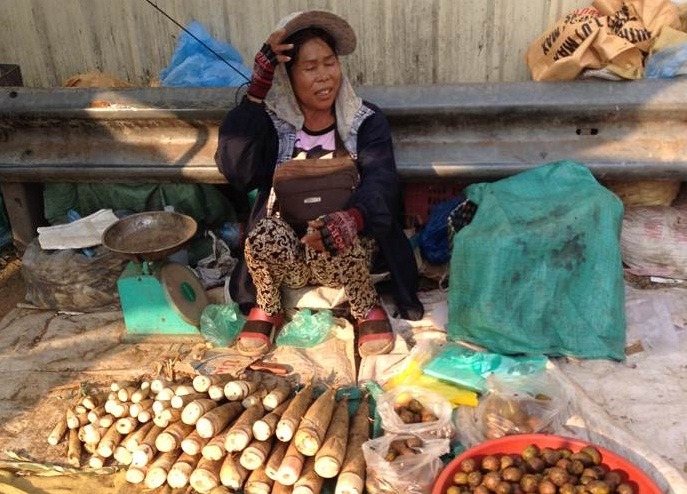Market vendors represent a large portion of small-scale traders in Lao PDR and women represent more than 90 percent of vendors in fresh food markets across the country. However, their roles often go unrecognized, even though they manage the entire value chain, from production to sales. Women vendors encounter many difficulties, such as a lack of representation in the decision-making; lack of knowledge and skills related to vocational development; and adversities obtaining credit to invest in their businesses.
A recent study by Rapid Asia, on behalf of UN Women, explored these issues to determine what can be done to give women more agency. That is, empowerment to influence decision making that impacts them and the ability to make free choices to control their own destinies. The below case study illustrates the difficult every-day life of many women market vendors in Vientiane. This was but one story out of many.
| Case Study
Two women who sold products near the entrance of Khuadin Market explained that they were not able to afford market fees, and instead opted to sell products near the market’s entrance. Vendor stalls were not permitted in that area, meaning they had been chased away by the police on several occasions. Eventually their stalls were confiscated by district tax officers. For their goods to be returned, the women were told to go to the district office. However, fearing a fine, neither woman went to claim her belongings. One of them said: “When I was setting up my stall, the district tax officer came and collected all of my things as well as the other vendors’ and asked us to go to the district tax office. But most of us didn’t go because we were afraid that they would give us a penalty. This is worse than not having any customers. It makes me feel terrible and insecure. This happened to me once when they took everything and they took away my coolers twice.” |
Looking first at existing policies, results showed that most regulations, laws and policies related to women market vendors were either gender blind or they did not proactively support the empowerment of women vendors. Documents on regulations and market management criteria only outlined general rules related to registration, infrastructure and designated market areas. Furthermore, the standards are broad and apply equally to both men and women. In addition, the only mechanism that governs general market operations is the Market Management Committee (MMC) which gives no assurance of women being represented in decision-making. However, there are some initiatives benefiting women vendors under the auspices of the Lao Women’s Union that provide access to financing and strengthen the women’s business management capacity. Unfortunately, these initiatives did not include women market vendors.
Nearly all stakeholders interviewed agreed that women market vendors in Vientiane Capital were an integral part of the urban economy. They were also aware of the problems faced by women market vendors: such as the inability to secure permanent stalls; the lack of proper market facilities; the lack of bargaining power to control the price of production; and a general lack of financial support. However, since most existing regulations, laws and policies are gender blind, concrete actions cannot be taken. The study confirmed that women encountered various challenges, including:
- Overburden from having to manage both their role at home and working in the market
- Loss or damage of products during transportation
- Unsuitable space to sell their goods
- Difficulties in obtaining permission for stall set up
- Uncomfortable market facilities
- Abuse and physical violence
- Conflicts with other vendors or authorities
- Exclusion from decision making and representation on the MMC
- Lack of information about existing assistance and support functions
Most women tended to quietly accept these injustices, even when being threatened by another party. They saw conflict as part of the daily work routine and didn’t think anyone could help. Despite the challenges, most of the women continued to work as vendors given that their daily income from the market was needed to support their families. Most of the women interviewed had never received any assistance or support from any organization.
There are a number of potential ways to empower women market vendors to give them more agency. And the recommendation was a series of proactive steps including:
- Organizing a group of women market vendors in order to strengthen their representation and improve bargaining power when dealing with the MMC.
- Raising awareness among women market vendors about their rights, existing assistance and support mechanisms as a potential way to address challenges stemming from a lack of information.
- Providing capacity building to women market vendors on necessary skills that respond to their needs as a crucial avenueto improve their businesses.
- Assisting these vendors by working with the MMC, market owners and village authorities to support women street vendors by granting permissions for them to sell their products in the markets or providing special conditions, such as lower market fees or special permits during certain hours of the day.
- lower market fees or special permits during certain hours of the day.
But the vision for women market vendors should not stop here. Once agency has been realized they should strive for more leadership, which goes beyond representation. It implies that women take the helm in development policies that impact them, lead communities, and make decisions. The full report was launched in Vientiane on 1 February, 2017.
If you found this article useful, please remember to ‘Like’, share on social media and/or hit the ‘Follow’ button to never miss an article. You may also be interested in the following article on Human Rights Based Measurement.
About the Author: Daniel Lindgren is the Founder of Rapid Asia Co., Ltd., a management consultancy firm based in Bangkok that specializes in evaluations for programs, projects, social marketing campaigns and other social development initiatives. Learn more about our work on: www.rapid-asia.com

